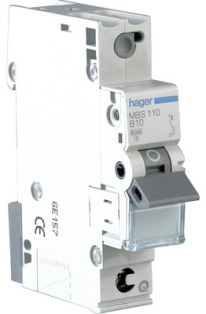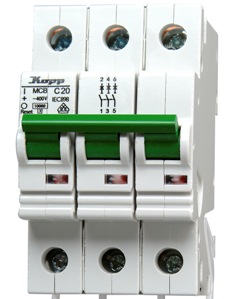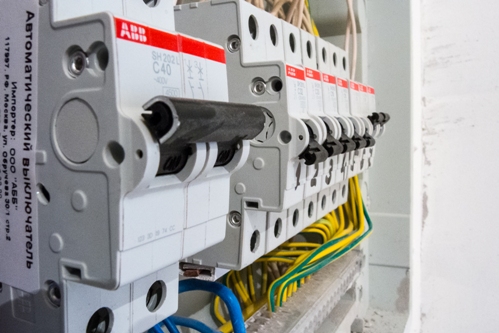Categories: Novice electricians, Automata and RCD
Number of views: 40288
Comments on the article: 4
The choice of a machine by the number of poles
 A circuit breaker is a low-voltage protective device that protects electrical circuits from emergency operating modes such as overload and short circuit, and also allows manual switching of electrical circuits under load. If the circuit breaker is structurally equipped with a motor-drive, then it can be controlled remotely or automatically by applying a signal from various automatic devices.
A circuit breaker is a low-voltage protective device that protects electrical circuits from emergency operating modes such as overload and short circuit, and also allows manual switching of electrical circuits under load. If the circuit breaker is structurally equipped with a motor-drive, then it can be controlled remotely or automatically by applying a signal from various automatic devices.
Circuit breakers are used quite widely, since the concept of "low-voltage circuits" includes not only power circuits supplying various electrical appliances and equipment, but also communication circuits, telemechanics of equipment, various auxiliary circuits with voltages up to 1000 V. In this article we present the features of choosing automatic circuit breaker according to such a criterion as the number of poles.
When choosing a circuit breaker, the number of poles in it is selected taking into account the characteristics of the electrical network. Consider when and where one-, two-, three- and four-pole machines are used.
220/380 V AC circuits
A three-phase electric network can supply both three-phase and single-phase consumers. Three-phase consumers - electric motors, transformers with a star or delta winding connection diagram are connected to the electric network by three conductors (three phases) and, accordingly, three-phase circuit breakers are installed to protect these consumers, which allow to completely break the circuit.
If the connection diagram of the windings of the electric motor or transformer is a “star with a derived zero point”, then to protect them, four-pole circuit breakers are installed that break three phase conductors and one zero.

Single-phase consumers are powered by a voltage of 220 V, which can be obtained by taking one of the phases and the neutral conductor (neutral) of the electrical network. That is, in this case, in addition to the three phases of the electric network, there is another conductor - zero, therefore, for the protection and switching of such an electric network, four-pole circuit breakers are installed that break all four conductors of the electric circuit.
There are also electrical appliances or equipment that structurally have three-phase and single-phase elements. For example, an electric machine constructively has several electric motors powered by three phases of an electric network. Moreover, to control these electric motors, a circuit powered by 220 V.
In this case, the circuit breaker that supplies voltage to the machine has four poles, and directly on the machine itself there are separate circuit breakers to protect each of the elements of the machine. Three-pole - for protecting electric motors, two-pole - for protecting control circuits and other auxiliary circuits of the machine.
A single-phase electric network is two-wire - one wire in it is phase, the other is zero. For switching and protecting electrical circuits, two-phase circuit breakers are used, which completely disconnect a section of the electrical network.

Both single-phase and three-phase switchboards can be installed single phase circuit breakerscarrying out food of separate single-phase consumers. These circuit breakers breaks the phase conductor of the electrical circuit.In this case, individual single-phase consumers are connected to the input (common) circuit breaker, which, as mentioned above, has two poles for a single-phase circuit and four poles for a three-phase circuit with a zero wire.

It should be noted that the gap of the neutral conductor is made if the mains has grounding system TN-S, which provides for the separation of the working neutral and protective conductors. The gap of the neutral conductor is carried out under the condition that zero will not come from another source. The gap of all conductors of the electrical circuit, including the neutral conductor, is required to ensure safety during maintenance of electrical wiring.
Two, three and four pole modular circuit breakers can be used to automate tripping of independent circuits. For example, one circuit is connected to one phase of a three-phase machine, and the other two to two other phases of the machine.
The thermal and electromagnetic releases of each of the poles of the modular circuit breaker operate independently of each other, and the pole levers are connected to each other, so if an overload or short circuit occurs on one circuit, two other circuits will be disconnected.

DC circuits
In addition to three-phase and single-phase AC networks, DC circuits exist. The DC circuit has two poles - "+" and "-", therefore, circuit breakers in these circuits are used bipolar. Single-phase circuit breakers are not used in DC circuits, since in these circuits it is necessary to ensure a break at the same time of two poles.
DC circuit breakers are used to protect circuits of electrified vehicles, in electrical installations in circuits of relay protection devices, automatics, in solenoid circuits of high-voltage circuit breakers, to power communication equipment, telemechanics, industrial control systems, as well as in various industrial automation devices.
Read also: Characteristics of circuit breakers

See also at bgv.electricianexp.com
:
